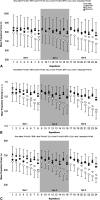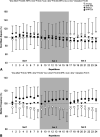Acute Responses to Traditional and Cluster-Set Squat Training With and Without Blood Flow Restriction
- PMID: 38780903
- PMCID: PMC11286160
- DOI: 10.1519/JSC.0000000000004820
Acute Responses to Traditional and Cluster-Set Squat Training With and Without Blood Flow Restriction
Abstract
Cornejo-Daza, PJ, Sánchez-Valdepeñas, J, Páez-Maldonado, J, Rodiles-Guerrero, L, Boullosa, D, León-Prados, JA, Wernbom, M, and Pareja-Blanco, F. Acute responses to traditional and cluster-set squat training with and without blood flow restriction. J Strength Cond Res 38(8): 1401-1412, 2024-To compare the acute responses to different set configurations (cluster [CLU] vs. traditional [TRA]) under distinct blood flow conditions (free vs. restricted) in full-squat (SQ). Twenty resistance-trained males performed 4 protocols that differed in the set configuration (TRA: continuous repetitions; vs. CLU: 30 seconds of rest every 2 repetitions) and in the blood flow condition (FF: free-flow; vs. blood flow restriction [BFR]: 50% of arterial occlusion pressure). The relative intensity (60% 1RM), volume (3 sets of 8 repetitions), and resting time (2 minutes) were equated. Mean propulsive force (MPF), velocity (MPV) and power (MPP), and electromyography (EMG) parameters were recorded during each repetition. Tensiomyography (TMG), blood lactate, countermovement jump (CMJ) height, maximal voluntary isometric contraction, in SQ, and movement velocity against the load that elicited a 1 m·s -1 velocity at baseline (V1-load) in SQ were assessed at pre- and post-exercise. The CLU protocols allowed a better maintenance of MPF, MPV, MPP, and EMG median frequency during the exercise compared to TRA (clu-time interaction, p < 0.05). The TRA protocols experienced greater impairments post-exercise in TMG- and EMG-derived variables (clu-time interaction, p < 0.05) and SQ and CMJ performance (clu-time interaction, p = 0.08 and p < 0.05, respectively), as well as higher blood lactate concentrations (clu-time interaction, p < 0.001) than CLU. Moreover, BFR displayed decreases in TMG variables (bfr-time interaction, p < 0.01), but BFR-CLU resulted in the greatest reduction in twitch contraction time ( p < 0.001). Cluster sets reduced fatigue during and after the training session and BFR exacerbated impairments in muscle mechanical properties; however, the combination of both could improve contraction speed after exercise.
Copyright © 2023 The Author(s). Published by Wolters Kluwer Health, Inc. on behalf of the National Strength and Conditioning Association.
Figures



References
-
- Bigland-Ritchie B, Jones DA, Woods JJ. Excitation frequency and muscle fatigue: Electrical responses during human voluntary and stimulated contractions. Exp Neurol 64: 414–427, 1979. - PubMed
-
- Brody LR, Pollock MT, Roy SH, De Luca CJ, Celli B. pH-induced effects on median frequency and conduction velocity of the myoelectric signal. J Appl Physiol 71: 1878–1885, 1991. - PubMed
-
- Buchthal F, Schmalbruch H. Contraction times and fibre types in intact human muscle. Acta Physiol Scand 79: 435–452, 1970. - PubMed
-
- Cook SB, Clark BC, Ploutz-Snyder LL. Effects of exercise load and blood-flow restriction on skeletal muscle function. Med Sci Sports Exerc 39: 1708–1713, 2007. - PubMed
-
- Courel-Ibáñez J, Martínez-Cava A, Morán-Navarro R, et al. . Reproducibility and repeatability of five different technologies for bar velocity measurement in resistance training. Ann Biomed Eng 47: 1523–1538, 2019. - PubMed
MeSH terms
Substances
Grants and funding
LinkOut - more resources
Full Text Sources
Research Materials
Miscellaneous

